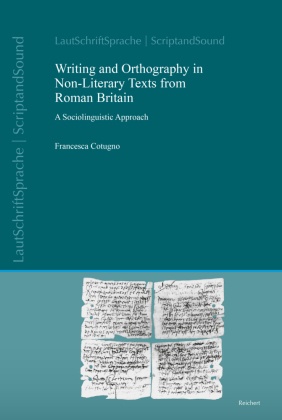Writing and Orthography in Non-Literary Texts from Roman Britain - A Sociolinguistic Approach
| Verlag | Reichert |
| Auflage | 2022 |
| Seiten | 172 |
| Format | 17,4 x 1,5 x 25,0 cm |
| Gewicht | 430 g |
| Artikeltyp | Englisches Buch |
| Reihe | LautSchriftSprache - ScriptandSound 4 |
| ISBN-10 | 3752006811 |
| EAN | 9783752006810 |
| Bestell-Nr | 75200681A |
The analysis of orthographic variation and the writing habit presented in this book represented a heuristic tool for the study of the sociolinguistic scenario of Roman Britain, sketching the different micro-histories of Latinization according to a new, ground-breaking, perspective. As a matter of fact, the assessment of the different orthographic variants may be revealing of the phenomena of language contact and interference; orthographic misspellings and idiosyncratic variants, which also varies according to the text type, writing materials, and writers, allows the sketch for different micro-histories of Latinization
The main aim of this book is an analysis of the orthographic variation observed in non-literary documents written on tablets in Roman Britain (i.e. Londinium-Bloomberg stylus tablets, the Carlisle and Vindolanda ink tablets, and curse tablets) taking into account any possible glimpse of language contact between the mother-tongue of the writers, conveniently hidden by the prestige of the Latin language and culture. These documents have been produced during the Roman control of Britannia, which lasted from 43 to about 410 CE, and was often characterised by a difficult relationship between the local population and the Romans. These non-literary documents show how these realities are fragmented in micro-entities, each of them carrying different linguistic, cultural, and historical backgrounds that we can summarize as micro-histories of Latinization. The topic of the "micro-histories" has been tackled according to the analysis of the orthographic variation which arises as a brand-new h euristic perspective for the assessment of the possible cases of language contact. In Roman Britain such contacts occurred in different historical occasions and also according to different manners: There is the commercial hub from Londinium, before and after the destruction of Boudica; the auxiliaries from Carlisle and Vindolanda which were from the Celto-Germanic territories of the Roman Empire, the local population which eventually learned the cursing practice.
The thorough analysis of this significant assortment of non-literary documents, which includes wax stylus tablets, ink tablets and lead tablets, written in different scripts such as Old and New Roman Cursive and Capital writings, offers a first comprehensive account of the language variation available in these texts according to the linguistic and palaeographical perspective. The different corpora considered, with their different orthographic and linguistic features, represent different community of speech, and analysi ng them offers also important insights concerning language contact and linguistic interaction in a way that so far has not be done before. The non-literary documents written on tablet have been published in the years but strongly oriented in one direction, sometimes towards a historical and palaeographical perspective, other times towards a strict linguistic perspective. In this way, the orthographic and the sociolinguistic intricacies of the non-literary documents from Britain have been left aside. In this book, instead, the main phenomena of orthographic variations have been systematically analysed, offering an in-depth investigation of the phenomena, accompanied by a study of the single phenomena, comparing each occurrence with their classical counterparts, their historical and sociolinguistic background, and taking into consideration the previous scholarship and the evidence from Latin Grammarians. This book is therefore intended for academic purposes, addressing an audience o f historical linguists, especially those interested in the sociolinguistic variability as intertwined in writing and speech.

